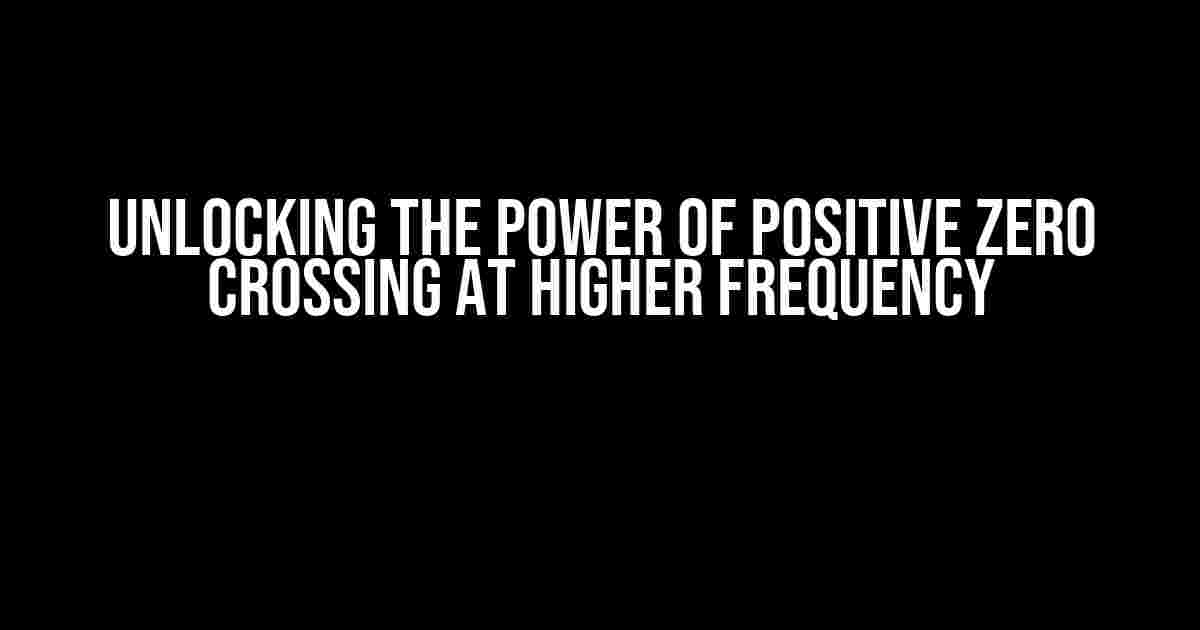Welcome to the world of signal processing, where the magic of Positive Zero Crossing at Higher Frequency (PZCHF) awaits! In this comprehensive guide, we’ll delve into the intricacies of PZCHF, exploring its definition, importance, and application in various fields. Buckle up, folks, as we embark on an exciting journey to unlock the secrets of this powerful technique.
What is Positive Zero Crossing at Higher Frequency?
PZCHF is a signal processing technique used to detect and analyze the zero-crossing points of a signal at higher frequencies. In simpler terms, it’s a method to identify the points where a signal changes its sign (positive to negative or vice versa) at a specific frequency range.
+---------------+
| Signal |
+---------------+
|
|
v
+---------------+
| Zero-Crossing |
| (Positive to |
| Negative) |
+---------------+
|
|
v
+---------------+
| Higher Frequency|
| Analysis |
+---------------+
Why is PZCHF Important?
PZCHF is a crucial technique in various fields, including:
- Audio Signal Processing: PZCHF helps in audio encoding, decoding, and compression. It’s essential for audio applications, such as speech recognition, music processing, and audio effects.
- Image Processing: PZCHF is used in image filtering, edge detection, and feature extraction. It’s vital for image recognition, object detection, and computer vision.
- Telecommunications: PZCHF is used in modem design, signal detection, and channel estimation. It’s crucial for reliable data transmission and reception.
- Biomedical Signal Processing: PZCHF is used in ECG, EEG, and other biomedical signal analysis. It helps in disease diagnosis, patient monitoring, and medical research.
How to Implement PZCHF?
Implementing PZCHF involves a series of steps:
- Signal Acquisition: Collect the signal data using sensors, microphones, or other acquisition devices.
- Signal Preprocessing: Clean and preprocess the signal data to remove noise and artifacts.
- Filtering: Apply filters (e.g., band-pass filters) to isolate the desired frequency range.
- Identify the zero-crossing points of the filtered signal using algorithms (e.g., peak detection, thresholding).
- Higher Frequency Analysis: Analyze the zero-crossing points at the desired higher frequency range.
Here’s a sample Python code to get you started:
import numpy as np from scipy import signal # Signal Acquisition (Example: Audio Signal) signal_data = np.random.rand(1000) # Replace with actual signal data # Signal Preprocessing (Example: Filtering) filtered_signal = signal.filtfilt(b, a, signal_data) # Zero-Crossing Detection zero_crossings = np.where(np.diff(np.sign(filtered_signal)))[0] # Higher Frequency Analysis higher_freq_signal = signal.resample(zero_crossings, 2*len(zero_crossings)) # Plot the results import matplotlib.pyplot as plt plt.plot(higher_freq_signal) plt.show()
PZCHF in Real-World Applications
Let’s explore some real-world applications of PZCHF:
| Application | Description |
|---|---|
| Audio Effects Pedals | PZCHF is used to create audio effects like distortion, overdrive, and reverb in music processing. |
| Medical Imaging | PZCHF is used in MRI and CT scanners to reconstruct high-resolution images of the body. |
| Speech Recognition | PZCHF is used to analyze audio signals and recognize spoken words in speech recognition systems. |
| Radar Systems | PZCHF is used in radar systems to detect and track objects using high-frequency signals. |
Challenges and Limitations of PZCHF
While PZCHF is a powerful technique, it’s not without its challenges and limitations:
- Noise and Interference: PZCHF is sensitive to noise and interference, which can affect the accuracy of zero-crossing detection.
- Sampling Rate:** The sampling rate of the signal acquisition device can affect the quality of the PZCHF analysis.
- Computational Complexity:** PZCHF can be computationally intensive, especially for high-frequency signals.
- Real-Time Implementation:** PZCHF can be challenging to implement in real-time systems due to the complexity of the algorithms.
Conclusion
In conclusion, Positive Zero Crossing at Higher Frequency is a powerful technique with far-reaching applications in various fields. By understanding the concepts, implementation, and challenges of PZCHF, you can unlock its potential to analyze and process signals at higher frequencies. Remember to stay curious, keep learning, and experiment with PZCHF to uncover its secrets!
Happy coding and signal processing!
Keywords: Positive Zero Crossing at Higher Frequency, signal processing, zero-crossing detection, higher frequency analysis, audio signal processing, image processing, telecommunications, biomedical signal processing.
Frequently Asked Question
Get ready to dive into the world of signal processing and clear your doubts about Positive Zero Crossing at Higher Frequency!
What is Positive Zero Crossing at Higher Frequency?
Positive Zero Crossing at Higher Frequency is a signal processing technique used to detect the instant when a signal crosses zero from negative to positive, but with a twist! It’s applied at higher frequencies, typically in the range of tens to hundreds of kilohertz, to accurately detect the zero-crossing points.
Why is Positive Zero Crossing necessary for signal analysis?
Positive Zero Crossing is essential for signal analysis because it helps to eliminate false triggering, reduces noise interference, and increases the accuracy of signal detection. By detecting the zero-crossing points, you can extract valuable information about the signal, such as its frequency, amplitude, and phase.
How does Positive Zero Crossing at Higher Frequency differ from traditional zero-crossing detection?
The key difference lies in the frequency range. Traditional zero-crossing detection is typically applied at lower frequencies, whereas Positive Zero Crossing at Higher Frequency is designed to operate at higher frequencies. This allows for more accurate detection of zero-crossing points, even in the presence of noise and interference.
What are the applications of Positive Zero Crossing at Higher Frequency?
Positive Zero Crossing at Higher Frequency has numerous applications in various fields, including power electronics, motor control, audio processing, and radar systems. It’s particularly useful in systems that require precise timing and synchronization, such as in power conversion and motor drive applications.
Can Positive Zero Crossing at Higher Frequency be implemented using analog circuits?
Yes, Positive Zero Crossing at Higher Frequency can be implemented using analog circuits, such as operational amplifiers and comparators. However, digital implementation using microcontrollers or digital signal processors is often preferred due to its flexibility, accuracy, and ease of implementation.

